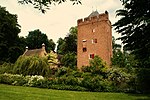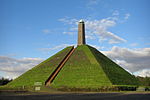Huis Doorn

Huis Doorn (Dutch pronunciation: [ɦœyz ˈdoːr(ə)n]; English: Doorn Manor) is a manor house and national museum in the town of Doorn in the Netherlands. The residence is appointed with early 20th century interior from the time when former German Emperor Wilhelm II resided (1919–1941). Huis Doorn was first built in the 13th century. It was rebuilt in the 14th century, after it was destroyed. It was again rebuilt in the 19th century to its present-day form. The gardens were designed in the 19th century. After World War I, Wilhelm II bought the house, where he lived in exile from 1920 until his death in 1941. He is buried in a coffin within a mausoleum in the gardens. After the German occupation in World War II, the house was seized by the Dutch government as hostile property. Huis Doorn is now a national museum and a national heritage site. The interior of the house has not been changed since Wilhelm II died. Every year in June, German monarchists come to Doorn to pay their respects to the emperor. In 2012, the museum had 25,000 visitors.
Excerpt from the Wikipedia article Huis Doorn (License: CC BY-SA 3.0, Authors, Images).Huis Doorn
Langbroekerweg, Utrechtse Heuvelrug
Geographical coordinates (GPS) Address Website Nearby Places Show on map
Geographical coordinates (GPS)
| Latitude | Longitude |
|---|---|
| N 52.0314 ° | E 5.3386 ° |
Address
Huis Doorn
Langbroekerweg 10
3941 NN Utrechtse Heuvelrug
Utrecht, Netherlands
Open on Google Maps










